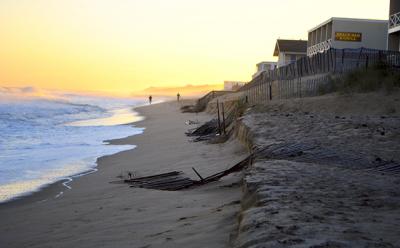Montauk Beach Project Looms

Even as storm-force winds blew across Montauk last week, sending waves high up onto the downtown beach where a line of sandbags covered with excavated sand is slated for construction by the Army Corps of Engineers, project contractors set up shop with a trailer at Montauk’s Kirk Park parking lot.
Opponents of the project — members of Defend H2O, a local environmental organization, the local Surfrider chapter, and several Montauk individuals — who sued in May to stop the reinforced dune, were denied an immediate restraining order last Thursday. They say the project will destroy the beach and remain hopeful for a court order that would halt the work, which is slated to begin after the Columbus Day holiday.
The lawsuit challenges the project as outside the bounds of East Hampton’s local waterfront revitalization project plan, which outlaws hard structures on the ocean beach. It is before Judge Arthur D. Spatt at Eastern District Federal Court.
Last week Judge Spatt transferred the request for an injunction to keep the project from moving forward while the lawsuit is adjudicated to Judge Anne Shields for determination.
The Army Corps and the town were to submit their argument to the court by today; the plaintiffs — East Hampton Town, New York State, and the Army Corps — have until tomorrow to respond.
As the start of construction looms, the downtown Montauk beach — where the 15-foot-tall artificial dune will stretch for almost three-quarters of a mile, with slopes onto and off of the dune spanning a width of 105 feet — was almost completely wave-washed earlier this week, with only about 20 feet of sand between the water line and sand fencing at the toe of small dunes up against shorefront motel buildings.
A photo circulated by Thomas Muse, a Montauk resident who is among those suing, showed the water on the downtown beach during the stormy end of last week practically at the natural dune. “Today this garden variety nor’easter has the ocean occupying the space where the wall is supposed to go. How is that going to work?” he asked on Facebook.
Mr. Muse also posted on Facebook a video and article about North Topsail Beach in North Carolina, where a sandbag wall has been installed. The article was written by Robert Young, a professor of coastal geology at Western Carolina University, who says the beach has been destroyed by the effect of the structure.
“This is a revetment,” Carl Irace, an East Hampton attorney representing the lawsuit plaintiffs, said this week. “This is the fundamental opposite of a dune. This is solid, 1.7-ton blocks.” Besides taking up the area of the beach, he said, the artificial dune will result in increased erosion.
“The beach is everyone’s resource,” he said.
